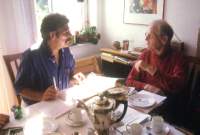genealogy
Index
Part 1
Part 2
Part 3
Part 4
Part 5
Part 6
Part 7
German
Audiofile
on this part
(German)
In the labyrinth of archives
Finding out after two world wars the identity of a German tourist who visited a cave in Kentucky at the turn of the last century is everything but simple. Expecially as Chuck could give us only some few reference points. An article from a 1909 issue of "Scientific American" with some data, not more.
Nevertheless: We knew that the wanted person was a citizen of Berlin and an engineer. And that he had come to the USA to study American production and mining methods.
The obvious idea to check the University archives in Berlin did not help us: The archives of the former Mining Academy were burned during the second world war. And in the Technical University the situation is the same. But there still exist the old address books of Berlin stored on microfilm in each larger library.
And indeed: In the address book of 1911 we find an engineer named Max Kaemper. However, this discovery does not help us a lot because the municipal archives of Berlin do not show where he had gone. "Everything lost in WW2", we are told laconically.
The central archives of the Evangelical Church in Berlin survived the war, but there is another problem: Under Data Protection Laws only relatives have access to the data. But itīs exactly those people we are looking for.
We plunge again into the address books: Max lived in the Hermannstrasse, in close neighbourhood to Heinrich Kaemper, the owner of an engine factory.
Since the early 20īs Elsbeth Kaemper, widow of an engineer, lived in the Grunewald. Obviously Max had not survived WW1.
20 years later, at the beginning of the 40's we find the factory owner at the same address.
We develop a hypothesis: Max, the son of a factory owner, travels to the USA in order to make professional contacts. He is killed in the First World War. His widow accomodates her father-in-law at the beginning of the Second World War. It sounds plausible - and turns out nevertheless to be a dead end. After we retraced Heinrich Kaemperīs track up to his birth place we find that Max was definitely NOT his son.
 We start another attempt and plunge again into the
address books.
We start another attempt and plunge again into the
address books.
We find that in 1931 Elsbeth
Kaemper, Maxīs widow, lived in close neighbourhood to one
Lina Kaemper, a generalīs widow.
And Max must have had a relationship with the Prussian military;
or else he would hardly have given the name "Moltke Dome" to a hall in Mammoth Cave.
Luck and coincidence help us:
An archivist in Berlin who became fond of our search
discovers the obituary of Lieutenant General
Hugo Kaemper. "His only son Max fell 1916 at the Somme"
was the crucial sentence for us.
Some further lucky coincidences - and nine months
after beginning of our search we have a telephone call with
the 87-year-old son of Max Kaemper.
 On the following weekend we sit together with Max Kaemperīs family.
They had heard about his journey to America in 1907/1908.
They knew as well that he had visited Mammoth Cave. But
that he was a legendary figure to American cavers
was unknown to the family.
On the following weekend we sit together with Max Kaemperīs family.
They had heard about his journey to America in 1907/1908.
They knew as well that he had visited Mammoth Cave. But
that he was a legendary figure to American cavers
was unknown to the family.
Nevertheless: Our assumption that Max had something to do with Heinrich, the factory owner, was not completely false. Heinrich was his cousin. And Mrs. Kaemper, the daughter-in-law of Max, even knows why he went to America:
 "He was to take over the Kaemper Engine Company. But
first he should see the world and get a wider view of things.
There were probably connections to America. He worked as a trainee at
different companies.
"He was to take over the Kaemper Engine Company. But
first he should see the world and get a wider view of things.
There were probably connections to America. He worked as a trainee at
different companies.
He should see the world and how they work over there.
This journey was a present from his parents,
a reward for his successful exam. "
| Previous | Start | Next |